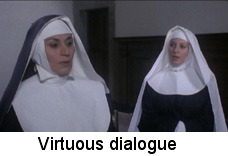3. Dialogue
| |
i) THE VIRTUES OF DIALOGUE |
 In literary fiction, you’ll often find page after page of a character’s inner thoughts and relatively little dialogue; in genre fiction, it’s more likely to be the other way round. A genre writer has to be good at writing dialogue; stodgy dialogue isn’t an option. In literary fiction, you’ll often find page after page of a character’s inner thoughts and relatively little dialogue; in genre fiction, it’s more likely to be the other way round. A genre writer has to be good at writing dialogue; stodgy dialogue isn’t an option.
Dialogue is a natural bridge between internal character and external action. Go deep into a character’s thoughts and you tend to leave the action behind. Stay inside someone’s mind for a long while and it can come as a sudden jerk for the reader when you switch back to doings in the external world.
Dialogue belongs in the same external world as the action, but it also conveys personality and shows how a character is thinking. Of course, people don’t always say what they’re thinking, but we’re used to reading between the lines. By years of practice, we’re all experts at interpreting the implications and motivations behind what other people actually say.
Inner thoughts aren’t necessarily the truth, anyway. Don’t we often think deceive ourselves, even inwardly, about our real motivations?
Good dialogue does many things at once. It advances the action, it reveals personality and motivation, and it keeps multiple characters in play. Above all, good dialogue is lively and very easy to read. That’s what I call value for money! |





